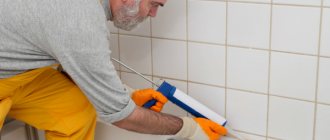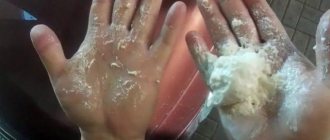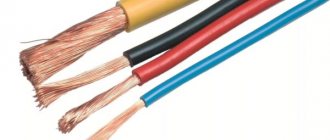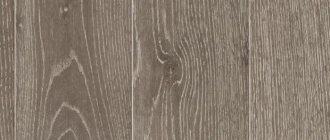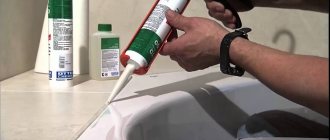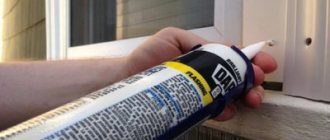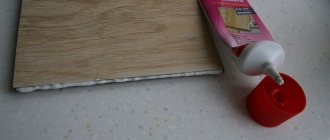A sealant is a paste-like substance based on polymers, the main purpose of which is to eliminate cracks and cracks. Construction stores offer us countless compounds with different functional purposes and areas of application:
- Heat resistant;
- Roofing;
- Sanitary;
- for sealing seams and cracks in floors and tiles.
How the sealant “works”: Voids and cracks are filled with a viscous two-, one- or multi-component composition; it hardens over time and a reliable sealing layer is formed.
Sealants have a high level of adhesion to various substrates
All sealants can be classified into several categories. When it comes to flooring sealants, there is a wide range. Depending on the floor covering - be it concrete, wood, stone, tile - there are nuances in the choice of composition, but in general they get along well with glass, metal, stone, wood and concrete, having a high adhesion coefficient with all these materials , they fill cracks in ceramic tiles. Before moving on to the specifics of choosing materials for concrete and wood floors, let's start with general terms, concepts and classifications.
According to the characteristics of the composition, sealants are:
- Acrylic;
- Silicone;
- Siliconized-acrylic;
- Polyurethane;
- Bitumen.
The latter, for example, are used only for external work, so they will not be able to seal cracks in a tiled bathroom floor.
Types of sealants for waterproofing tile joints
The composition of materials characterized by hydrophobicity includes components that prevent the penetration of moisture into the cladding structure. This is due to filling the pores of the base, creating an impermeable layer. The materials are divided into 3 groups:
- cement;
- polymer;
- based on resins.
Combined mixtures are popular. They contain 2 active ingredients, for example, cement-polymer, epoxy-cement. The composition determines the properties of the material and based on this the sealant is selected. Operating conditions should be taken into account: intensity of exposure to water, air parameters (humidity, temperature).
Cement grouts
This is the most common option due to its affordable price and average characteristics.
Such compositions can be found in the range of products from different manufacturers. There are single- and multi-component sealants. The first group includes mixtures that contain cement. Sand is not used. Cement mixtures are used to fill joint joints of small width - less than 4 mm. However, when using such a material without special additives, cracks may soon appear. This is due to the fact that the cement mortar is not characterized by elasticity, which means that the coating will not withstand the effects of deformation loads (compression and tension).
In order to increase strength, a plasticizer is used; due to this component, the service life of the coating increases and the resistance to temperature changes increases.
Cement-sand mixtures are used to finish the joints between the tiles and the wall. In these areas, the width of the suture joints often exceeds 4 mm, which means that the use of pure cement mixture is not recommended.
Portland cement is popular. It is characterized by a fine-grained structure, therefore it is often used to fill narrow cracks. The composition also often includes a lime component to improve properties. Cement mortars may contain a coloring pigment, making the coating more attractive.
Silicone based fillers
Such mixtures are characterized by high elasticity. They do not deform under the influence of loads, since they tend to retain their original shape. The main component is silicone. Thanks to it, areas adjacent to plumbing fixtures in the bathroom and kitchen are sealed.
Silicone mixtures do not lose their qualities from exposure to temperature changes. However, such material cannot withstand the influence of intense loads. For this reason, they are not used to lay tiles in high-traffic areas. Due to its moisture resistance, the service life of the coating increases significantly.
Silicone mixtures tolerate the influence of extremely high and low air temperatures: -50...+200°C, without being destroyed.
Use acidic silicone-based sealants with caution. Such mixtures can contribute to the development of rust on the surface of metal elements.
A universal option is a neutral composition. However, it comes at a higher price.
A construction gun is used to work with sealants. Thanks to a nozzle with a small hole at the end, this tool helps fill joints in difficult areas, for example, near baseboards, curbs and other corner joints.
Epoxy resin based compositions
Materials in this group consist directly of epoxy resin and hardener. These components are packaged separately. They are mixed before surface treatment. This need is due to the fact that the material quickly hardens.
You need to work with it quickly - within 5 minutes the mixture begins to set. After this, it will be impractical to seal the seams with such material.
Advantages of epoxy resin:
- strength;
- elasticity;
- long service period;
- moisture resistance;
- versatility: the material can be used for various purposes, including for fastening tiles.
The solution must be removed from the coating immediately. If this is not done, the tiles will become very dirty during the repair process. It will be difficult to clean it from the epoxy mixture later.
Features of working with furan and polyurethane grouts
Furan resins are based on furfural, extracted from plant waste in agriculture and wood. To prepare a mixture with the required characteristics, it is also necessary to use a hardener, as in the case of epoxy resin. This material is a strong acid or its salt. The concentration of this component is up to 30% of the total volume of the finished mixture.
Furan resin contains coke, andesite or graphite as a filler. The hardening process takes several days if the work is carried out at room temperature. You can speed it up; to do this, you need to apply the mixture in a cold environment. When exposed to temperatures ranging from -60 to -80°C, the material will harden in a few hours.
Compared to analogues, furan resin stands out for its increased strength. Moreover, in this parameter it surpasses even epoxy resin, which is reliable in operation.
Another advantage of furan mixture is chemical resistance. This material is characterized by high adhesion to ceramics and other materials.
Furan resin can be combined with other varieties: epoxy or phenolic. This mixture has only one drawback - it is not elastic.
Polyurethane sealant, on the contrary, can withstand significant deformation loads. This is due to increased elasticity, which allows the layer of material to maintain its original shape.
This type of sealant does not need to be combined with other components. It is already ready for use. Sold in sealed plastic containers.
Polyurethane composition is recommended for filling joints with a width of 2-5 mm. It is characterized by its ability to withstand prolonged contact with water without the risk of wetting the subgrade.
Useful tips
Finally, let's look at some useful tips:
- Some people use detergent to remove excess caulk. However, this is the wrong approach - washing liquids vary greatly in composition, and some liquids do not dissolve sealant well and can damage the joint.
- You can also find bitumen sealants on sale. They have excellent technical properties, but they are not suitable for finishing houses or apartments (difficult to prepare, difficult to apply, dries slowly, cannot be painted).
In conclusion, we also note that store-bought sealants today are quite cheap - ranging from 200 to 600 rubles per tube.
Examples of good manufacturers of sealing compounds are Tytan, Ceresit, Moment, Soudal, Makroflex. They are available at any hardware store and are of good quality and reliability. How to work with silicone video
Choosing a sealant for waterproofing tile joints in a bathroom of the required quality
When considering the option of laying tiles in a bathroom, you need to protect the subfloor by filling the seams with sealant. The choice is made taking into account the requirements for materials used in rooms with high humidity:
- homogeneity of composition: uniform consistency without inclusions or large fractions;
- a sufficient degree of viscosity and elasticity, which will avoid cracking of seam joints when the material expands;
- for installation on the wall, compositions with an average strength rating are used, and for installation on the floor, the most reliable mixtures are chosen;
- water resistance, this criterion is met by most modern compositions, except for cement mixtures that absorb moisture during prolonged contact with it;
- hydrophobic properties that the material retains throughout the entire period of operation.
Pay attention to the shade of the mixture. It should fit well into the interior design.
What adhesive is suitable for finishing borders?
The adhesive for fixing skirting boards must meet the following requirements:
- moisture resistance and mechanical strength;
- high early strength;
- high resistance to deformation;
- combination of adhesive ability and sealing;
- high degree of adhesion to PVC and ceramics;
- low turnover.
In particular, the universal polyurethane adhesive and sealant SikaFlex®-11FC+ (i-Cure) meets these requirements. It is highly resistant to water and corrosion, and does not lose strength and elasticity over time.
Acrylic adhesives are also suitable for these purposes. For example, SikaBond-525 is easy to use and adheres well to various materials.
Preparation for sealing seams and joints with sealant
Work begins with preparing tools and materials:
- rubber spatula;
- container for preparing the solution;
- construction gun;
- rags, sponge;
- masking tape;
- primer mixture for surface impregnation;
- acetone for degreasing;
- respirator, gloves.
The coating is cleaned of dust. The mixture should be applied to primed surfaces. Tape tapes are glued along the seams, which will create a kind of edges that protect the tiles from contamination.
Sometimes it is necessary to renew the coating at the joints of the tiles. To do this, first remove the layer of old material. You should prepare a special chemical-based remover: in the form of a paste or aerosol.
Such materials are used in a ventilated area, as they often contain aggressive components. To avoid damaging the coating, it is recommended to apply the composition to a small area. The duration of action of the wash, its amount during processing - these parameters are determined by the manufacturer. It is important to prepare rubber gloves and a respirator.
If required, compositions of this type are applied to the seam joints several times. This need arises when it was not possible to completely remove the moisture-resistant material from the seams during initial processing.
What to consider when choosing
Currently, there are a great variety of compounds on the market that were developed specifically for bathrooms and showers. Unlike other materials, they must have the following qualities:
- High resistance to water. This is the most important indicator. Some types are so persistent that they are even applied to the bottom and walls of the pool. Of course, these are more professional connections.
- Low shrinkage. If this value is shown to be very high, then such a solution is used under special conditions. Improper use will lead to cracks and damage to the tiles.
- High level of adhesion to the base. That is, the adhesion of the two materials should be quite reliable. Therefore, it is necessary to carefully study the instructions.
- Long service life. Naturally, each manufacturer indicates maximum terms, but they depend on the characteristics described above and the intended use.
- Wide range of colors. Decorative components cannot be ignored. Otherwise, you can get a reliable surface that you don’t want to look at.
On a note! On the modern market there are mixtures that have different visual effects: they shine, change color or are completely transparent. They are great for creating various types of interiors, but it is better not to use them for the bathroom. The more foreign additives, the less protective properties.
New to the construction market - shiny grout, not recommended for use in the bathroom
Proper waterproofing of tile joints with sealant
They use a construction gun, thanks to which the seam joint becomes smoother and thinner.
First you need to cut the spout correctly - at an angle. The width of the future seam depends on the diameter of the hole.
After the sealant is installed in the gun, they begin to squeeze it out. Moreover, it is important to do this without interruption in order to obtain a uniform seam. Excess mixture is removed with a rubber spatula. You need to wait until the sealant has completely set. Then they begin to clean the coating from the masking tape.
How to properly attach curbs (plinths)?
If the gap between the bathtub and the wall exceeds 2-3 cm, it is better to pre-fill it with foam.
Plastic skirting boards are cut to fit the seam. The corners are cut at an angle of 45° and connected with PVC corners. Caps are placed on the outer edges of the curbs. It is better to mark the borders for gluing borders with masking tape. The glue must be applied to the back surface of the baseboard so that it completely covers it. There should be no breaks in the adhesive layer.
Then the baseboard is placed along the line of the masking tape and pressed against both surfaces. The glue should set within a few minutes. Only after this can the curb be released.
Installing a ceramic border is not fundamentally different from installing a plastic one. In either case, after drying, all joints should be treated with sanitary grout.
Methods for sealing the joint between the wall and plumbing
The choice of option is made taking into account the width of the gap in a given area:
- leaks are eliminated with a layer of sealant; the principle of applying the mixture is the same as on other surfaces;
- install decorative borders, they must match the interior;
- the gap is filled with mounting foam with moisture-resistant properties, then the curb is fixed, and the seams in the areas where it joins the wall and bathtub are protected with sealant;
- border tape is used, often it is made in the form of a self-adhesive strip; for fastening, the material is bent in the center and fixed on the wall and bathtub; this tape has a polyethylene base and does not get wet.
The first 2 methods are suitable for working with narrow gaps. The latter methods are used to fill wide gaps between the wall and the bathtub.
Grout colors
In most cases, manufacturers rely on basic shades. The most commonly used grout colors are:
- white;
- black;
- green;
- dark brown;
- blue.
There are transparent silicone grouts with antifungal properties. If you don’t have a suitable tone, you can purchase several different colors and mix them.
To get the most uniform surface possible, the grout should match the color of the tile.
You can create a more unusual interior using contrasting grout.
For more information about grout colors, read the article - How to choose grout for tiles by color: secrets that only a few know
Polyurethane
Sealants are made from viscous polymer components of synthetic origin. Polyurethane types are designed for use under extreme conditions and under heavy loads. To improve characteristics, various additives are added to the composition.
Features of the product
Polyurethane varieties are considered one of the best sealants for the bathroom. The substances combine the functions of adhesive and insulating agents. Elastic properties reach 99%, which is higher than that of silicone options. Under any mechanical stress, corners and seams (old, new) will remain sealed. Sanitary models are often used to seal water pipe outlets and for gluing all types of surfaces.
Polyurethane sealants are resistant to vibration and corrosion. When used in damp conditions, the insulating qualities increase. The characteristics of the substance resemble polyurethane foam. After application to the surface, polymerization processes are activated, as a result of which the product dries quickly.
Elastic look for the bathroom Source decorstudia.com.ua
Tool
To apply grout, it is best to use a special rubber spatula. It allows you not only to increase the speed of finishing, but also to fill even the smallest seams. This tool does not leave excess grout on the wall.
If you don't have a rubber spatula, you can use a grater. To do this, take sandpaper and round one of its corners. This application tool does not always fill the seam completely, so sometimes you will need to adjust the angles of your fingers.
You need to wear rubber gloves when working, as grout that gets on your skin can ruin it.
To perform grouting work, you will also need a sponge, a clean and dry rag and a bucket of water.
